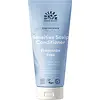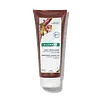What's inside
What's inside
 Key Ingredients
Key Ingredients

 Benefits
Benefits

 Concerns
Concerns

 Ingredients Side-by-side
Ingredients Side-by-side

Water
Skin ConditioningAloe Barbadensis Leaf Extract
EmollientPropanediol
SolventCetyl Alcohol
EmollientDistearoylethyl Dimonium Chloride
C15-19 Alkane
SolventGlycerin
HumectantCetearyl Alcohol
EmollientGlyceryl Caprylate
EmollientButyrospermum Parkii Butter
Skin ConditioningCocos Nucifera Oil
MaskingSimmondsia Chinensis Seed Oil
EmollientBeta-Sitosterol
Emulsion StabilisingStearyl Glycyrrhetinate
Skin ConditioningSqualene
EmollientXylitol
HumectantGlyceryl Stearate Se
EmulsifyingTocopherol
AntioxidantWater, Aloe Barbadensis Leaf Extract, Propanediol, Cetyl Alcohol, Distearoylethyl Dimonium Chloride, C15-19 Alkane, Glycerin, Cetearyl Alcohol, Glyceryl Caprylate, Butyrospermum Parkii Butter, Cocos Nucifera Oil, Simmondsia Chinensis Seed Oil, Beta-Sitosterol, Stearyl Glycyrrhetinate, Squalene, Xylitol, Glyceryl Stearate Se, Tocopherol
Water
Skin ConditioningHydroxypropyl Starch Phosphate
Cetearyl Alcohol
EmollientBehenamidopropyl Dimethylamine
EmulsifyingGlycerin
HumectantCoco-Caprylate/Caprate
Emollient1,2-Hexanediol
Skin ConditioningCinchona Succirubra Bark Extract
Skin ConditioningLeontopodium Alpinum Flower/Leaf Extract
Skin ConditioningCaffeine
Skin ConditioningBiotin
AntiseborrhoeicNiacinamide
SmoothingPanthenol
Skin ConditioningHelianthus Annuus Seed Oil
EmollientAlcohol
AntimicrobialBenzoic Acid
MaskingCeteareth-33
CleansingCitric Acid
BufferingParfum
MaskingLactic Acid
BufferingPantolactone
HumectantPotassium Sorbate
PreservativePyridoxine Hcl
Skin ConditioningSodium Benzoate
MaskingTocopherol
AntioxidantTrisodium Ethylenediamine Disuccinate
Water, Hydroxypropyl Starch Phosphate, Cetearyl Alcohol, Behenamidopropyl Dimethylamine, Glycerin, Coco-Caprylate/Caprate, 1,2-Hexanediol, Cinchona Succirubra Bark Extract, Leontopodium Alpinum Flower/Leaf Extract, Caffeine, Biotin, Niacinamide, Panthenol, Helianthus Annuus Seed Oil, Alcohol, Benzoic Acid, Ceteareth-33, Citric Acid, Parfum, Lactic Acid, Pantolactone, Potassium Sorbate, Pyridoxine Hcl, Sodium Benzoate, Tocopherol, Trisodium Ethylenediamine Disuccinate
Ingredients Explained
These ingredients are found in both products.
Ingredients higher up in an ingredient list are typically present in a larger amount.
Cetearyl alcohol is a mixture of two fatty alcohols: cetyl alcohol and stearyl alcohol. It is mainly used as an emulsifier. Emulsifiers help prevent the separation of oils and products. Due to its composition, it can also be used to thicken a product or help create foam.
Cetearyl alcohol is an emollient. Emollients help soothe and hydrate the skin by trapping moisture.
Studies show Cetearyl alcohol is non-toxic and non-irritating. The FDA allows products labeled "alcohol-free" to have fatty alcohols.
This ingredient is usually derived from plant oils such as palm, vegetable, or coconut oils. There is debate on whether this ingredient will cause acne.
Due to the fatty acid base, this ingredient may not be Malassezia folliculitis safe.
Learn more about Cetearyl AlcoholGlycerin is already naturally found in your skin. It helps moisturize and protect your skin.
A study from 2016 found glycerin to be more effective as a humectant than AHAs and hyaluronic acid.
As a humectant, it helps the skin stay hydrated by pulling moisture to your skin. The low molecular weight of glycerin allows it to pull moisture into the deeper layers of your skin.
Hydrated skin improves your skin barrier; Your skin barrier helps protect against irritants and bacteria.
Glycerin has also been found to have antimicrobial and antiviral properties. Due to these properties, glycerin is often used in wound and burn treatments.
In cosmetics, glycerin is usually derived from plants such as soybean or palm. However, it can also be sourced from animals, such as tallow or animal fat.
This ingredient is organic, colorless, odorless, and non-toxic.
Glycerin is the name for this ingredient in American English. British English uses Glycerol/Glycerine.
Learn more about GlycerinTocopherol (also known as Vitamin E) is a common antioxidant used to help protect the skin from free-radicals and strengthen the skin barrier. It's also fat soluble - this means our skin is great at absorbing it.
Vitamin E also helps keep your natural skin lipids healthy. Your lipid skin barrier naturally consists of lipids, ceramides, and fatty acids. Vitamin E offers extra protection for your skin’s lipid barrier, keeping your skin healthy and nourished.
Another benefit is a bit of UV protection. Vitamin E helps reduce the damage caused by UVB rays. (It should not replace your sunscreen). Combining it with Vitamin C can decrease sunburned cells and hyperpigmentation after UV exposure.
You might have noticed Vitamin E + C often paired together. This is because it is great at stabilizing Vitamin C. Using the two together helps increase the effectiveness of both ingredients.
There are often claims that Vitamin E can reduce/prevent scarring, but these claims haven't been confirmed by scientific research.
Learn more about TocopherolWater. It's the most common cosmetic ingredient of all. You'll usually see it at the top of ingredient lists, meaning that it makes up the largest part of the product.
So why is it so popular? Water most often acts as a solvent - this means that it helps dissolve other ingredients into the formulation.
You'll also recognize water as that liquid we all need to stay alive. If you see this, drink a glass of water. Stay hydrated!
Learn more about Water